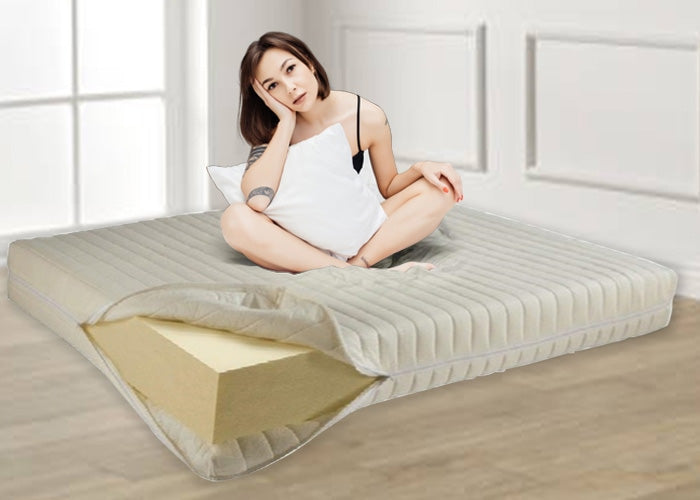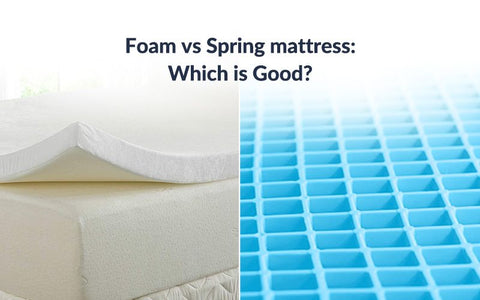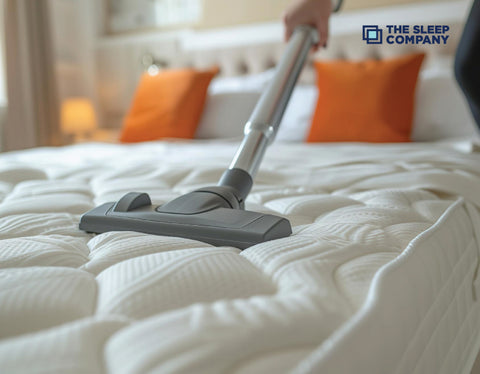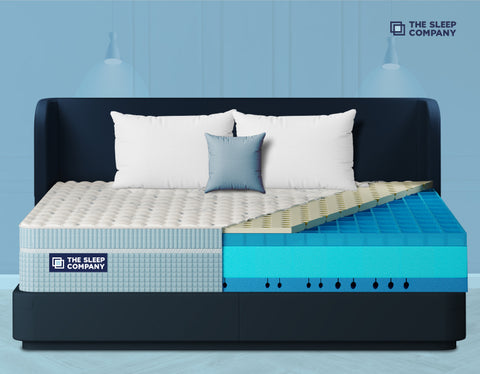My Cart

15 Reasons to Stop Sleeping on Memory Foam Mattress
Memory foam mattresses have grown in popularity in recent years, and many sleepers who suffer from hip, back, or shoulder pain find that memory foam mattresses provide unparalleled pressure relief. Some sleepers, however, are still hesitant to choose a memory foam mattress, citing concerns about the health and safety of the chemicals used to make memory foam.
While finding a comfortable mattress is a top priority, it also makes sense to research the health and safety of the mattress you’re considering purchasing. Buy mattress online is no joke and it can be a tedious job. There are various types of mattresses on the market and choosing the right mattress online can be confusing. Memory foam mattresses are the most popular choice when it comes to buy mattress online, one of the reasons can be that people are not well aware of the other mattresses.
The emergence of Memory Foam Mattress

Memory foam is a type of polyurethane foam. Memory foam, like all foams, compresses when under pressure. However, Memory foam differs from other polyurethane foams as it contains additional chemicals that increase its viscosity and elasticity, hence its alternate name, viscoelastic foam. When pressure is applied to memory foam, it can be stretched into various shapes and then slowly return to its original shape when the pressure is removed. Memory foam excels at absorbing energy to provide pressure relief due to these characteristics. NASA developed memory foam in the 1960s to provide cushioning against vibrations and potential crashes. The material was later used to prevent bedsores in patients who were unable to move for extended periods of time.
Mattresses made from memory foam have an almost sterling reputation. In the 90s, they were the go-to mattress for those looking for luxury. They come with a hefty price tag, promising to provide unrivaled comfort, as well as assistance with back pain. But are memory foam mattresses everything they’re cracked up to be? New research suggests that they may not be as good for you as clever marketing might have you believe. We’ll delve deeper into what memory foam is, and here are 15 reasons why you should rethink before you buy memory mattress online.
15 reasons why you should rethink before you buy memory Mattress
1. Retention of Heat
One of the most common complaints about memory foam mattresses is that they trap heat and become uncomfortably warm. Memory foam, particularly traditional memory foam, can become quite warm due to its design to respond to body heat and the density of the material.
Despite advancements in memory foam technology to address this issue such as open cell and gel foams, as well as other cooling construction methods, they still retain heat more than other types of mattresses. This can make it difficult to fall and stay asleep, especially if you’re already a hot sleeper. This makes it an unsuitable option for people from hotter regions or who sleep in the summer, but it is ideal for winter or colder regions.
2. Is it worth it?
Another disadvantage of memory foam mattresses is that they are more expensive than other types of mattresses. This is especially true if you get a particularly high-quality memory foam mattress: To buy memory foam mattresses online are typically more expensive than comparable-quality innerspring mattresses. As memory foam mattresses become more popular, particularly as mattress-in-a-box companies gain popularity, the overall cost of memory foam mattresses has decreased. However, it is still the more expensive option.
3. Waterproof? Oops NO
Water, and moisture/liquid in general, can damage memory foam mattresses as well as memory foam toppers and pillows. Liquids have the potential to degrade the foam and shorten the lifespan of a memory foam mattress. This is especially inconvenient if you live in a humid climate or have a young child or pet who is prone to spills or accidents. It also makes cleaning a memory foam mattress challenging.
4. Sinking into eternity
Some people complain that the memory foam causes them to feel stuck or sucked up into the material. This can make it difficult to move during the night, and some people find it generally uncomfortable or off-putting. Sinkage in a memory foam mattress tends to increase with age, so people who are particularly bothered by it will grow to dislike it even more over time.
5. Chemical-like odor & Off-Gassing
Memory foam mattresses have a distinct, chemical-like odor when they are first manufactured. This is known as “off-gassing.” The smell usually goes away within 24 hours of unboxing, but it can sometimes linger for weeks. Cheaper memory foam mattresses have stronger and longer-lasting off-gassing.
6. Difficult to move
Many memory foam mattresses now come in the form of a mattress in a box, giving the impression that they are lightweight. This, however, is not always the case. Once set up, a memory foam mattress is significantly heavier than other types of mattresses. This can cause problems when attempting to lift the mattress to change the sheets or reposition the mattress. It can also be a major pain when moving, especially if you have a mattress in a box because it will most likely be much more difficult to get the mattress out of the room than it was to bring it in.
Memory foam mattresses can be heavier than other types of mattresses. The weight may be an issue for those who prefer to rotate their mattresses every so often for mattress preservation; it may also be an issue for those who move around due to temporary stays.
7. Lack of support
Memory foam mattresses have caused discomfort and failed to offer enough support to the body. One of the main reasons for this could be that the material used is of poor quality, or that other parts, such as the cover, are of poor quality. A low-quality memory foam mattress may have a variety of problems, including discomfort, odors, hot spots, a lack of support, and a short lifespan. If you’re planning to buy mattress online, sacrificing quality for a lower price is not a good long-term investment.
8. Not suitable for all seasons
The mattress may be softer than expected in hot climates and harder than expected in cold climates. However, thanks to central heating and cooling systems, most homes are kept at a temperature that is neither too soft nor too hard for the mattress.
9. Motion Transfer
Memory foam mattresses have separate foam structures that allow movements to be separated and undetectable. These aid in reducing motion transfer, so you are unaware whether your partner is nearby. Consider something other than a memory foam mattress if you prefer more intimacy but also disruption over independent experiences.
10. Unnecessary Fillers
Silica and calcium carbonate are two common foam fillers. The fillers can shorten the lifespan of your mattress. Fiberglass is not a good material for a mattress. It is due to the presence of carcinogenic properties. Some unqualified manufacturers use toxic chemicals or materials in memory foam mattresses, such as formaldehyde, naphthalene, isocyanates, and benzene. According to studies and observations, these materials are toxic and may irritate the nose, throat, skin, and eyes.
When looking to buy mattress online, look for a high-quality, reputable mattress company brand, such as The Sleep Company.
11. High maintenance
Most of us are aware that memory foam mattresses require extensive maintenance and care to provide long-term benefits. Any spill, heavy weight, or temperature change could disrupt the foam structure of the memory foam mattress. It requires special care and attention.
12. Allergy Symptoms
Memory foam mattresses can be problematic for some people, such as those who have allergies, asthma, or other respiratory conditions. If you are extremely sensitive to smells, memory foam may also bother you. Allergic reactions can be triggered in a variety of ways. Specific odors can be irritating; accumulated dust can cause a reaction, and even the materials that make up the foam itself can be problematic. Moreover, Some of the isocyanates found in memory foam mattresses can cause harm to the skin. These can also cause respiration problems. Isocyanate compounds irritate the skin and are harmful to human health.
13. Increase the risk of Sudden Infant Death Syndrome
The symptoms of exposure to the dangers of foam mattresses can be identified. These include morning headaches, muscle pain, nausea, and a general lack of concentration. Young children are most commonly reported to have impaired cognitive ability. Particularly in those who have used memory foam mattresses. They have difficulty concentrating, frequent headaches, and respiratory problems. Studies support data that suggests that memory foam and other extremely soft bedding can increase the risk of Sudden Infant Death Syndrome. Soft bedding like memory foam can trap carbon dioxide, which can be fatal to your infant. You mustn’t let your children sleep on memory foam mattresses.
14. Not suitable for every sleep position
If you move around a lot during the night and do not stick to a single sleep position, memory foam mattresses may be a problem for you. It will take some time for the memory foam to adjust from one position to the next. It will cradle your body slowly, but not immediately. Some mattresses can conform in a shorter period than others. Memory foam has a distinct lack of springiness, which elastic foam is better known for.
15. Toxic Components
The main ingredient of memory foam is polyurethane. This compound comes from petroleum as a byproduct. During the process of making memory foam, polyurethane is often mixed with other harmful compounds, including polyvinyl chloride, formaldehyde, boric acid, antimony trioxide, and different types of petrochemicals. The effects of toxic materials typically emerge during the off-gassing process when a mattress is first used. People with weaker immune systems or allergies can be especially vulnerable to strong odors and hazardous substances.
Is Memory Foam Safe?

Many people have been sleeping on memory foam mattresses every night for years with no problems. However, the majority of materials that go through an off-gassing phase are toxic and can drastically impact your health in the future. People with weakened immune systems are the first to exhibit symptoms. These substances may emit gaseous compound derivatives during home use.
Toxic buildup in humans is caused by the chemical breakdown of volatile organic compounds. This has the potential to have serious consequences for human health. These byproducts are dispersed into the bedroom air and can accumulate. This impairs breathing and causes a slew of allergic reactions. These unstable substances are the primary cause of rapid deterioration in health. VOCs can still be released even though they are more stable in finished products such as memory foam. This only occurs under certain conditions during use. They are typically detected by a strong odor in the air surrounding the products. Typically, those are made of polyurethane.
What does the research suggest?
The researchers were testing the effects of VOCs on lab mice. And the results from the four different mattress manufacturers revealed that all of the memory foam mattresses caused respiratory problems. The irritation to the lungs was so severe that it reduced the airflow to the mice’s lungs by one-fifth of their total intake capacity.
Final thoughts
Many products which seem to be very exciting at first sight also have a less attractive side which remains often undetected because manufacturers do not talk about it. So do also Memory-Foam mattresses which have been promoted strongly for many years (and still are) by one of the leading mattress producers and by many smaller manufacturers who tried to capture a part of that market. Since its introduction a quarter century ago, it is evident that memory foam mattresses are old and it’s the right time to say goodbye to memory foam mattresses.
Further Reading

Foam vs Spring mattress: Which is Good?
April 25, 2024

3 Types of Mattresses Which is Good for You in 2024
April 24, 2024

How to Extend the Lifespan of Your Mattress
April 23, 2024

Waterbed Or SmartGRID Mattress? Which Is Better In Summer?
April 22, 2024

What Type of Mattress is Best for Summer?
April 22, 2024


